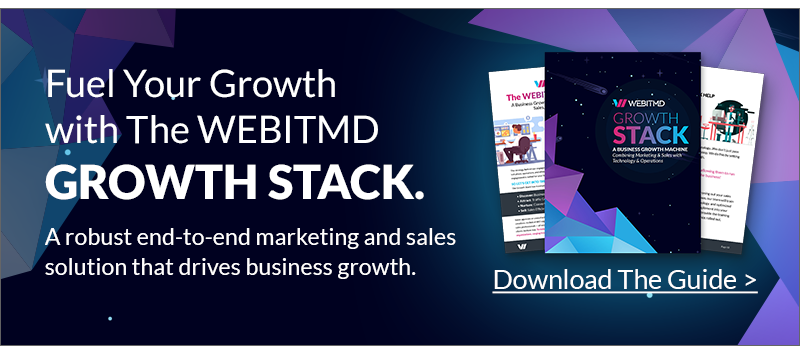SEO is one of several strategies used to generate top-of-funnel traffic with the goal to convert leads. This is extremely challenging for internal marketing teams and agencies alike because it requires attracting people you have zero data on. But technology-supported marketing provides a number of opportunities that not only produce accurate audience-targeting tactics but also improve efficiency and cut cost.
This article is intended to help business owners of any size, corporate internal marketing teams, and members of the C-Suite discover who technology stacks and accompanying strategies can improve SEO results and create a channel for organic-generated consistent growth.
How does SEO Work Without the Technology Play?
SEO as a strategy without any adjoining tools focuses on assumed keywords. Once these have been determined, the next steps usually ensue:
- Titles, tags and meta descriptions are re-written for their use
- Keywords are sprinkled across various web pages
- Blogs are written to boost their ranking
- Backlinks are created to boost ranking
Look at the above list, and think about the man-hours and financial investment in performing these tasks, many of which are re-occurring at a minimum monthly basis with a maximum weekly.
Now remind yourself that ALL of these tasks are performed on assumptions, as there were no tech tools used to gather data and perform audience-targeting tactics, nor are there tools in place to monitor the strategy for effectiveness. This is why organizations partner with growth-driven SEO agencies that utilize a stack of tools and strategies to achieve their client’s goals.
How Tech Tools Improve Your SEO Keywords and Content
It is of prime importance to think big picture when defining your keywords. This means you need to consider your target audiences, as well as how Google’s algorithm associates them to ranking consistency. Keywords and content are the driving forces of a successful SEO campaign, and technology plays a massive role in maximizing their effectiveness in the following ways:
- Discover and define semantic related keywords
- Determine monthly search volume
- Define seasonality in keyword ranking
- Uncover geo-specific regions and rankings
- Score your anchor texts
- Crawl site at all levels for keyword usage
- Send alerts for potential penalties
- Monitor ranking
- Show correlations between ranking and other internal and external factors
- Generate ideas for keywords and content topics
- Score content for SEO-friendliness
- Spy on competitor keywords, ranking history, and overall SEO performance
The best marketing stacks will strive to reduce the number of tools while ensuring that every need is a featured function on the necessary platforms. So if you can find a single tool or even one that performs all of these, you will help your marketing budget and improve efficiency by having every functionality in one or few places.
How Technology Stacks Help Generate SEO Leads
Once a team has created the SEO strategy based on the research and data farming performed by the various tools in your Growth Stack, the next move is to monitor the results once launched.
SEO, even when run by the best digital marketing agency using an advanced growth stack, is still a process. As a general rule of thumb, you will want to give the strategy three months to generate enough data worth studying. Most SEO agencies that don’t offer growth stacks or that lack technology will solely rely on Google Analytics–a free tool that allows webmasters to see engagement data on their website.
The problem is, you can’t put a face to the web visitor, nor can you see their detailed journey. Knowing these things IS HUGE because it allows for you to know exactly who your buyers are, how they became a lead, and which specific pieces of content they engaged with before. This will then help you fine-tune the strategy to convert organic traffic in fewer steps. It also created direct marketing opportunities, and at this point your SEO has just exploded into a number of other side-strategies, like email marketing.
Advanced CRMs like HubSpot perform all the above tasks, and more when it comes to generating leads from SEO. For example, this tool can allow you to see the name of the person who came to your site from an organic click, what company they work for, their job role, and much more high-level data that can be injected into the content strategy to increase organic rankings for audience-specific search terms and keywords, and these are the search terms that convert at higher volume in less time than their larger, broad counterparts.
Converting Leads with a Technology Stack
Today’s buyers are savvy and indulge in researching tons of information before making a purchasing decision. They consume web page content, blogs, white papers, guides, review sites, message boards and social media pages. An amazing technology stack will help reduce the time it takes to convert a lead from SEO, while nurturing the fence-sitters through an educational funnel designed to speak to them at every stage of the buyer’s journey.
Once your organic leads come in, you can use a CRM to set the cadence for when you start automating content to them that has been customized to address their pain point. Remember, the idea is to show people how your products and services provide the best solution to their problems. So if “Outdoorsman Dan” (your buyer persona created from previously captured lead data and other avenues) wants to buy a drone, but it has to be user friendly for both his kids aged 6 and 13, automated content can be sent to him featuring a drone with adjustable skill levels that can withstand crashes.
Converting SEO leads that don’t roll over right away means you accommodate buyers who aren’t yet ready to make a purchasing decision by feeding them the right content that addresses their needs, and gives assurance they are face to face with the product of their dreams. Without a CRM that can take leads from SEO, qualify them, segment them into the right buyer persona, and put them in a funnel to receive automated content that will help them make a purchasing decision, you are leaving money on the table while enabling your competitors to grow.
Want to Learn More About How SEO and Technology Work Together?
This article didn’t mention it, but all of the data generated by technology pieces can be fed into a CRM allowing marketers to measure how profitable individual pieces are of a digital marketing strategy. Feels good to invest in something you know works!
Download our FREE guide on the Growth Stack, and give us a call to determine if your business might be a great fit.









.jpg)



.jpg)





![5 Reports to Elevate Your HubSpot Sales Dashboard [+ Examples]](https://blog.webitmd.com/hs-fs/hubfs/Imported_Blog_Media/6-winning-examples-of-a-hubspot-sales-dashboard-2.png?width=767&name=6-winning-examples-of-a-hubspot-sales-dashboard-2.png)